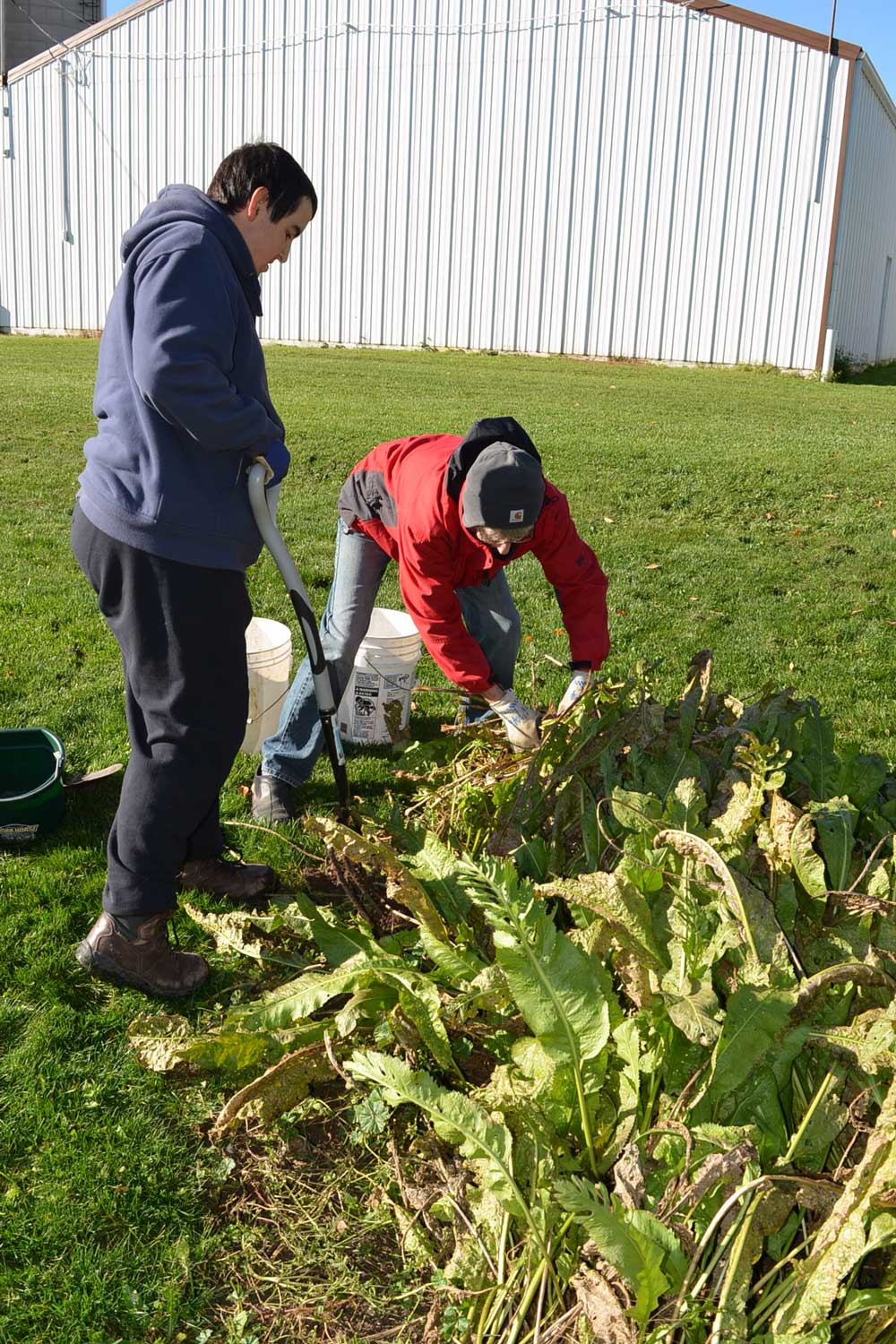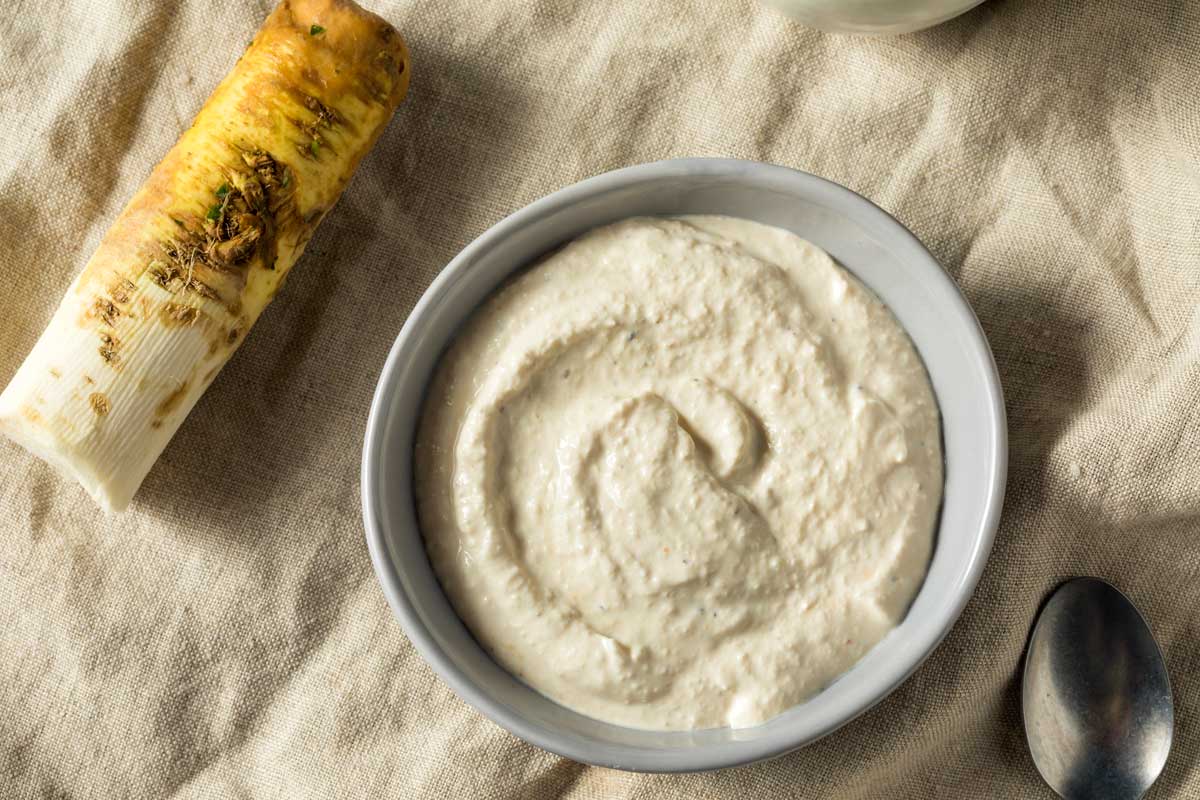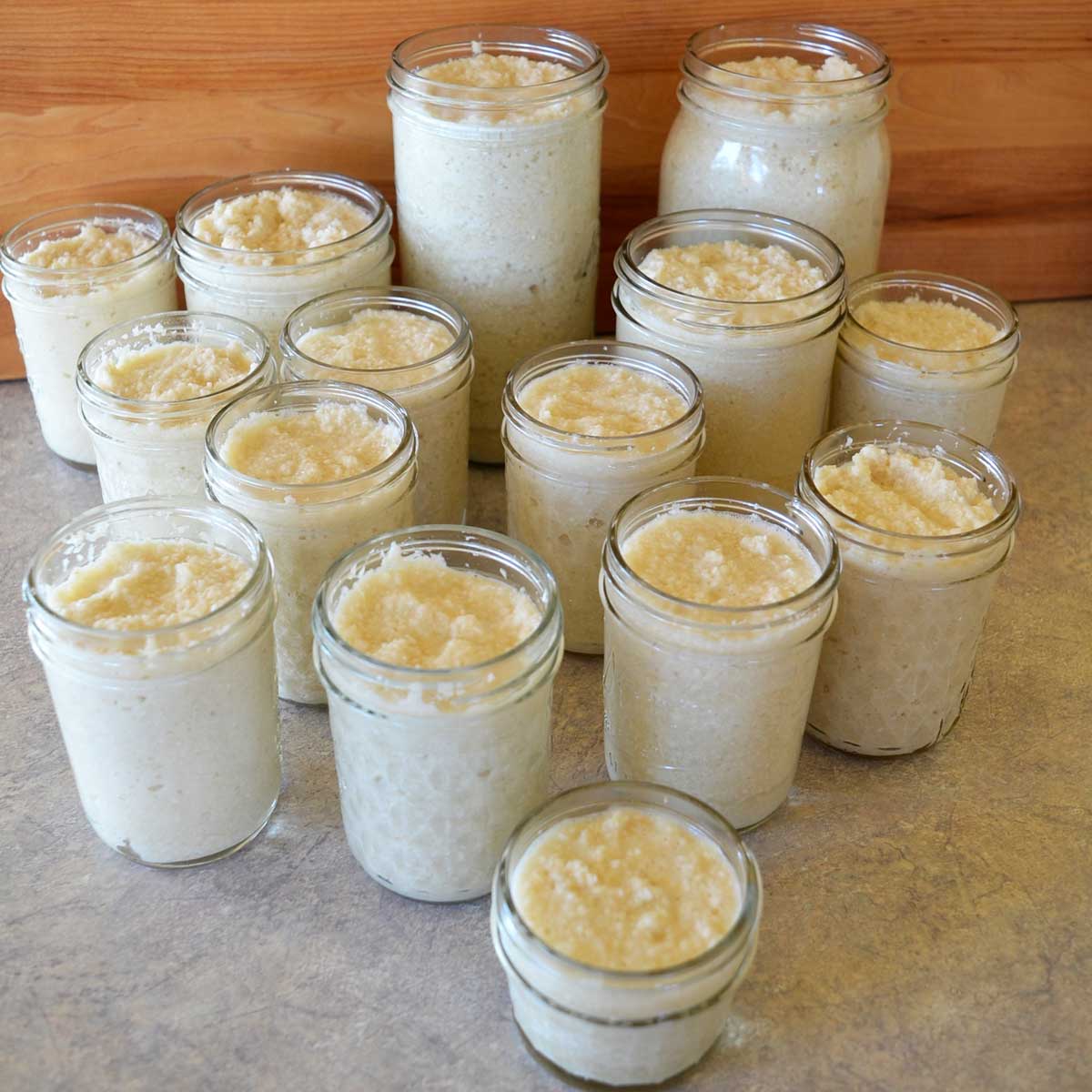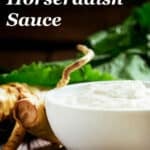Easy Horseradish Sauce Recipe with Fresh Horseradish Root
This post may contain affiliate links. Read my full disclosure here.
We’ll share how to make basic horseradish sauce, cream sauce and cocktail sauce with fresh horseradish root and common pantry ingredients. The kick of homemade sauce knocks the socks off of most store bought sauce!
My first foray into horseradish sauce happened as a result of conversation with my son’s piano teacher, Miss Betty. (Some of you may remember her from her rye bread and pickle recipes.)
Betty and her husband have a huge patch of horseradish, but this year her husband said he didn’t want to make homemade horseradish sauce because it was too much work. (They are getting up in years, so the digging and cleaning is becoming more of a chore.)
Never one to miss an opportunity to learn to try something new in the kitchen, I told her that we’d be happy to give her a hand. (We’ve since established our own horseradish patch.)

Table of contents
Digging Horseradish
My youngest and I went over in the morning to dig the roots. Warning – horseradish roots can be deep and strong! While attempting to muscle the roots out of the ground, my son bent the handle of the steel garden fork. (Time to check out whether or not the “Lifetime Warranty” covers horseradish damage…)
We weren’t quite sure how much to dig, so we dug quite a few – and ended up with enough horseradish sauce for a small army. 🙂

After digging, we washed the worst of the mud off with a garden hose. Then we went back to our kitchen and did the peeling and chopping.
Because we had so much horseradish, I placed the cubed horseradish in water with citric acid in it to prevent browning. You could also use salt water or water with lemon juice.
Betty and her husband normally work in small batches (1 cup of horseradish, as specified in the recipe), so they skip the anti-browning treatment.
Betty shared her family’s two horseradish sauce recipes with me – one basic pickled sauce, and a horseradish cream sauce made with the basic sauce. You can use apple cider vinegar if you prefer, but it will give the sauce a darker color.

Fresh Horseradish Sauce Recipe
Ingredients
- 1 cup horseradish, peeled and cut into 1/2″ cubes
- 1/2 cup white vinegar
- 2 tablespoons sugar
- 1/4 teaspoon salt
Directions
Put all ingredients into a blender or food processor at high speed. Blend until creamy. Put in a jar and store in the refrigerator.
Note: If you don’t have a food processor or blender, grate of finely chop the horseradish root and blend with other ingredients. To enhance the “kick” of the horseradish, grate or grind it first, and then wait a few minutes before adding the rest of the ingredients.
There is no USDA approved method for canning horseradish sauce. Store it in the refrigerator or freezer. The vinegar acts as a preservative, and it will last for at least three months.
Creamy Horseradish Sauce Recipe
Ingredients
- 2 tablespoons prepared horseradish sauce
- 1/2 cup mayonnaise
- 1/2 teaspoon vinegar
- Salt and pepper to taste
Directions
Would you like to save this?
In a small bowl, blend all ingredients. Makes about 1 cup. Store in refrigerator.

Horseradish Cocktail Sauce
Another simple use of the basic horseradish sauce it to mix it to taste with ketchup for a quick cocktail sauce. This is my sons’ favorite way to eat horseradish.
A Note on Horseradish
Betty and I were talking about how very few people make homemade horseradish sauce anymore, even when they have access to a horseradish patch.
The big batch we did took a couple hours (with digging and cleaning), but we ended up with four quarts of sauce. (I’m gifting out horseradish to local friends and family this fall.) If you were only making a cup, it wouldn’t take much time at all.

I think that perhaps our modern palates are spoiled by the abundance of food choices available in the average grocery store, and how much fresh produce is available all year round.
In the olden days, folks were more appreciative of the zip of horseradish when they had to rely on storage food all winter. The same might be said of heavy spiced cakes and cookies.
I find when baking that spice cakes and cookies are much more appreciated by the older crowd, while young palates more commonly go for chocolate or vanilla.
Watch out for the Horseradish Kick!
Be careful when working with the ground horseradish root! I could smell the vapors as we were chopping, but it wasn’t until I leaned over the bowl of the food processor that the full effect hit me.
My eyes started watering, my nose started running – I cleared sinuses that I didn’t know I had. I had to step away for a moment and wipe the tears, and when I came back, I made sure to keep the sauce at arms’ length.
Horseradish and wasabi are both rooty members of the cabbage family. They release a compound called allyl isothiocyanate, which is responsible for that pungent burn. The pungency will fade over time as the sauce sits in the fridge, but when it’s fresh, watch out!
Using Your Sauce
Horseradish sauce is commonly served with beef, such as roast beef sandwiches, beef tenderloin or standing rib roast. The boys have taken to adding a bit of sauce in all sorts of things, like mac and cheese.
Horseradish is one of those foods that people either love or hate, but if you’re on the fence, you may want to give it a chance.
Why?
Though used as a condiment, horseradish contains glucosinolates and isothiocyanates.
Historically, it’s been used to fight bacterial and fungal infections, improve breathing issues, detoxify the liver, and more. Learn more about the medicinal use of horseradish.
If you access to some in the garden or farmers market, give it a try.
PrintEasy Horseradish Sauce
Simple recipes for homemade horseradish sauce – plain or cream style – made with fresh horseradish root.
- Prep Time: 5 minutes
- Total Time: 5 minutes
- Yield: 1.5 cups 1x
- Category: Condiment
Ingredients
For basic sauce:
- 1 cup horseradish, peeled and cut into 1/2″ cubes
- 1/2 cup white vinegar
- 2 tablespoons sugar
- 1/4 teaspoon salt
For creamed sauce:
- 2 tablespoons prepared horseradish sauce
- 1/2 cup mayonnaise
- 1/2 teaspoon vinegar
- Salt and pepper to taste
Instructions
For Basic Sauce:
- Put all ingredients into a blender or food processor at high speed. Blend until creamy. Put in a jar and store in the refrigerator.
For Creamed Sauce:
- In a small bowl, blend all ingredients. Makes about 1 cup. Store in refrigerator.
Notes
- If you don’t have a food processor or blender, grate the horseradish root as finely as possible and blend with other ingredients for the basic sauce.
More Old Fashioned Made From Scratch Recipes
- Grandma Catherine’s Carrot Cake with Cream Cheese Frosting
- Church Dinner Chicken
- Pickle Relish Sweetened With Honey
Originally posted in 2016, last updated in 2025.





I made this (sort of) last year and mixed the horseradish with ACV after its time in the food processor. I then froze all but a small jar. We kept the fresh horseradish in ACV in the fridge and it lasted quite well. I was able to scoop out a tablespoon or two at a time and blend with sour cream or clabber with homemade garlic mayonnaise for enhancing prime rib or ketchup and a dash of Worcestershire and a dash of lemon to go with seafood and it made for some sauces that were far better than store bought.
I found that if you blend the Horseradish by itself first then add the other ingredients then it gave a better kick, don’t pass out when you get too close.
lol – thanks for the tip and the warning.
I loved your recipes and will add them to my list of staples. Thank you! I use less horseradish sauce these days because my Cypriot wife does not like the “kick”. Your article reminded me of an experience I had in 1983. I worked with a butcher in Cyprus to show some friends what a U.S. steak might look like. Of course I needed some horseradish sauce. In the past I had made it with my father who grew some roots in Central NY. I bought the root at an open farmer’s market in Nicosia and brought it back to my room. Washed and peeled I started to grate it. A few minutes later, when I could breathe again, I put on my scuba mask to finish the task. I can testify that horseradish grown under the Middle Eastern sun is MUCH stronger than anything I had found in the United States (I have not tried buying in the Southwest.) So, if you get the opportunity, try it, but be very careful!
I’m not sure I’d be comfortable with that much heat, but I’m sure it would be a memorable experience.
You mentioned your boys adding horseradish to their mac’n’cheese. (I’ll have to give that a try!) I like to add a tablespoon or two when I mix up some chicken salad, or ham salad. Just enough to get the taste and a bit of zing. My daughters won’t touch it, but I’ve won a couple of the grand-kids over.
My boys were leery of it early on, but they’ve learned to appreciate it.
I am 70 years old now, but when I was in my early 20s I briefly worked at a pricey restaurant, where the kitchen was on the second floor, requiring the servers to go up and down constantly to retrieve customer’s dishes and assorted other things. This became a problem one day, as it was horseradish sauce making day, and we all had red eyes and noses after each visit to the kitchen! LOL
Happily I was already a fan of the flavor, and enjoy it to this day! My life was too hectic for many years to try growing it, and then health issues became an impediment.
Nowadays I am healthier than in years, but I now live in central Gulf coast Florida, on a postage-stamp sized lot in a 55+ community, so I’m not sure I can grow it now, but I’m seriously considering trying it in a spot behind the trailer that gets morning sun, but is shaded during the worst of the heat. In the meantime I have seen raw root available at a couple local stores, so I definitely plan to put my blender to good use one of these days! That creamy style is so good as a condiment with cold sliced beef!
Thanks for sharing your horseradish story. At least that way, the customers had proof that the sauce was fresh.
Given that you live in a hot climate, I bet the horseradish would do well in that spot.
I really like horseradish and hope to grow my own this year.
I have always used a very similar recipe. Question is can I substitute honey for the sugar.
Yes, it should work. Honey provides more sweetness per unit volume than sugar, so you may want to reduce the amount. For jam and jelly making, we use half as much honey as sugar to get the same level of sweetness.
Honey, like sugar, is hygroscopic, which means that is absorbs and binds water. It’s also slightly acidic, which aids in preservation.
Oh MY, it looks great! Can’t wait to cook em this Sunday!
This is our first go at making homemade horseradish. It was planted in the fall of 2021 and has never been dug. My grandpa always processed horseradish in the spring. It doesn’t sound like the preferred time but is it ok to harvest at this time of year? Also when prepping to freeze….should it be peeled First?
Thanks!
Yes, it’s okay to harvest in early spring, before the roots put too much energy into growing greens. Spring harvested roots will be a little sweeter. If freezing whole roots, I’d leave the peelings on to protect the roots.
Aged, mellow horse radish can be achieved with this recipe, a freezer and patience.
Since there have been freezers, I was always taught to never fill the jar too full. Keep the liquid over the raw horseradish, but a keep pinky finger, about 1/4 inch, of liquid from touching the top of the jar at minimum.
The liquid expands in the cold, and you do not want the jar to break. Put the jar in a bag also if you worry about it expanding and overflowing (I always do). In a deep freezer, a 3/8 inch or 1/2 gap is great. Always clean the top of the jar with hot water before you put the lid on, even during use. A tight seal is essential for horseradish flavor to keep in the jar and not in the air of the freezer or fridge.
Make your chosen simple vinegar based ground horseradish recipe. The finer it is ground, the “hotter” it will be.
As the jars in the deep freeze age, the hot flavor becomes a lot more mellow and the earthy flavor starts to arise. In a deep freezer, between 15 and -5 degrees F, label the date the jar went in. Fresh or less than 5-6 freezer months is a great for stand out flavor dishes, shrimp cocktail and other tomato sauces. 9 months becomes great for adding to stews, chilis and hearty dishes that require less fluid in the mix.
After 1 year or more, your NEVER OPENED frozen year old jar with look a bit golden, because it is. Use this as your taste buds desire. Patience pays off. Keep this cycle going and after 1 year you will have every flavor of horseradish for your food and your health. It may not seem easy, as I learned from my grandfather, because at first it, it is not. The true reward comes later, like most special things in life.
For horseradish to be used with beef, I like the Mayo/sour cream combo half and half, with fresh grated horseradish. I add a bit of Dijon mustard, white wine vinegar, kosher salt, and freshly ground pepper. This may sound unorthodox, but I add a few dashes of Worcestershire sauce which I don’t use on anything but it worked here. Garnish with chopped chives.
For cocktail sauce I prefer Heinz Chili Sauce, rather than ketchup. Add grated fresh horseradish and a splash of fresh lemon juice.
Great thread! I have canned in water bath and kept in fridge. Adding some fruit fresh to preserve the color. I have limited freezer space so I am going to try to dry some. Thanks for the good idea. I am also going to try and freeze a few whole roots. My patch didn’t get harvested last year, so this year some was split and woody but still plenty to use. I love mustards and horseradish. My favorite is on a BLT! [who can afford prime rib! ] I also have extra of fresh garlic and I am going to add some to my horseradish for a try. Not all batches but some. I will also gift some away to family and friends. I have broken food processors with horseradish root, good ones too! Waiting for a hard freeze or two helps the flavor too. I have used my Nana’s meat grinder too. I am going to try and use a new one. I’d love to find the patch in Northern MN! Yum
My creamy horseradish sauce uses 1/4 c of each mayonnaise and sour cream. My recipe for cocktail sauce includes 1/4 tsp lemon juice.
Horseradish is far too invasive for a patch. I grow it in pots. When I want to harvest about a year’s worth, I’ll choice to repot it in a larger pot or divide it. No more breaking my fork.
I grow ginger and turmeric the same way.
I want to grow horseradish this year, do you have any words of wisdom or advice for starting a container plant?
Hello, love all these comments as well as the recipe. Can you tell me if it is possible to freeze the horseradish cream? I have a ton of it!. Thanks, Sue
It’s likely to separate, and the flavor may mellow, but it should still be usable as long as you’re okay with a texture change.
I have read that you can freeze the roots and grate as needed. I have never tried to freeze the horseradish cream after I’ve made it. I doubt that it would be as pungent as freshly made.
My husband loves this recipe! Thanks, I didn’t have a clue how to make it.
Glad we were able to help, Shirley.
With freezer space limited, I dry a lot of produce. Last year I dried some of the extra root and then ground it to a powder in my spice grinder. I reconstitute it, in small batches, with white wine vinegar, add sugar and salt and voila! “Fresh” horseradish sauce. Pungent and great for adding to casseroles, etc.
Is it extremely fragrant while drying, or not too bad?
Some folks say out of the kitchen when doing industrial quantities of this stuff, esp. around Easter time. Peel, chop and mix in the garage with the door open. It can get pretty toxic.
I won’t probably ever make this, it is too easy to purchase prepared product for two people. I will note that real Wasabe is very expensive and what we buy reasonably in the supermarket for Wasabe is colored horse radish product. Not bad, just not real Wasabe. I love it all. My mouth is watering just typing this.
I watched a video of one of the traditional wasabi makers – such time and care involved. If you’re only making for two people, you could whip it up quite fast with minimal discomfort. It was only as we worked through the bin of roots (and I leaned over the grinder) that things became more pungent.
Love your website! For storing horseradish, my Granny always filled a deep long box with dry sand and buried the harvested roots in that. You then keep the box in a dry, cool, dark spot, like the basement or crawl. They keep very well right into the next harvest. We have ‘fresh’ roots all year that way.
Thanks, Karen.
I tried this method last fall with a few roots and just looked at them the other I actually forgot about them and they were in pretty good shape, So this year I will put bigger size roots in the sand.
Another question why does the ground up root that you froze lose allot of it’s heat when you defrost it?
Thanks Marcie
It’s basic food chemistry. The compounds in the root that make it hot react to air and start breaking down when you grind it. So if you grind it, freeze it, and thaw it, there’s a fair amount of time for that reaction to happen, and you lose heat. It would be better to freeze roots whole, or freeze the sauce with vinegar.
From the horseradish people at horseradish.org:
Thank you so much for the great info.
You’re welcome.
Oh I forgot to mention dig horseradish in a month that has an R in it. Don’t know why but my Mom told me that years ago. So I only dig it up in the fall usually September.
Marcie
Yes, you don’t want to dig the roots during the growing season, because the plant pulls up energy out of the root for foliage.
Thanks for the reply. I often wondered why the digging exclusions. But it makes sense like removing foliage of tulip bulbs etc…. I planted the crowns that I cut off the root so I can have my own patch.
We use an old fashion meat grinder for our horseradish and freeze it in small jars that I save during the year. One cup jelly jars work good also. We like a little on pizza. Mix it with ketchup for a good shrimp sauce.
I never thought of horseradish on pizza. Thanks for the tip.
I take my food processor outside and set up my horseradish making on the picnic table. The first time I made horseradish, I was in the kitchen and the fumes were so strong I had tears streaming down my face. My husband thought it was hilarious!
My family loves fresh horseradish!
Nice to know that the roots can be kept in the refrigerator until you need them.
I bet your sinuses were clear for the rest of the day. 😉
I made horse radish sauce today for the first time. I read, somewhere, that letting the shredded horse radish chill in the frig for 30 minutes before adding vinegar would maximize ‘heat’. So I tried that. We’ll see!!!!
I know that letting garlic or onions sit, chopped, intensifies their flavor/odor, so it wouldn’t surprise me if the same thing works for horseradish.
The first time I made fresh horseradish sauce, I had to hold a towel over my face while I was processing it. The tears were streaming down my face! Now I take all my equipment, my food processor, and extension cord outside to my picnic table when making horseradish. I usually make about a dozen pints at a time because everyone in the family wants some.
First time I grated horseradish was in Cyprus. An ancient island near Lebanon and Israel, Cyprus is a natural home for one of the “bitter herbs” in the Seder plate. Because the sun is strong in Cyprus, so is the horseradish! When I grated my first root I was literally forced out of the kitchen by the pungent aroma. I returned with my scuba mask on and all was well.
Good potency on those roots. 🙂
Yes the smell makes your nostrils swell your eyes run and your nose runs!!!!
But God is it good!!!
I started a patch 2 yrs ago when I moved to a new location so a month that has an R in it so it is my time to dig some to see how its going under ground!!!!!
This sounds great! I love horseradish, but don’t always like the sauces I buy in the store. Great idea for making your own. I’ve never seen horseradish in the grocery store, but then again, I’ve never looked. I’m sure I can find it somewhere!
Hi I live in Northern MN and there is a huge natural peat bog in an area where I live and a Wisconsin company comes and loads semi’s up with the horseradish root and takes them back to WI for processing. The name of the horseradish in the stores is called Silver Springs and it is an excellent product. You may not have it in your area but if you do it is very good. I do process my own when I can find the roots.
I’m gonna try to make horseradish that taste like Silver Spring Applewood Smoke flavored Horseradish sauce.
I’m addicted to it.
I grow my own horseradish and now I want cranberry flavor too. Wish me luck.
I live 1 1/2 north of Eau Clair WI
If you find the flavor you like, share the recipe!
Ask someone where it is located – I can find it in my stores in Dallas, but so many of them have so many additives, I won’t buy them. The best (read the label) ingredients for horseradish are these: horseradish, vinegar, salt. That’s it. When they start putting cream, mayonnaise, etc., in the ingredients it defeats the whole purpose of just having horseradish in my opinion. Hope you find it in a store near you! Marilyn Lee @cantstopcooking
I agree 100%. Thank you!
Whole Foods on Amazon does deliver horseradish roots
I read that to keep your horseradish under control you were to only plant as much as you could eat in a year. I have horseradish and I love it. I am going to try to can 1 half cup jar this year. If it works then next year I will see if I can get my in-laws patch under control. I love the the old spices and try to grow as many of my own herbs and crush them when I need them. It makes such a big difference in flavor.
The planting only as much as you need is a good theory, but can be hard to implement in real life. Any bit of root left behind can and usually will grow into a whole new plant. I’m sure the neighbors didn’t start with a 12 foot long patch of horseradish, but after numerous decades, they now could keep the whole township supplied.
You are absolutely right on the flavor of fresh and properly preserved herbs versus most of what’s in the supermarkets. It’s like night and day.
Try a bit of horseradish in ham and bean soup.
Grandma suggested this and WOW it is excellent, give it a try.
Grandma’s rule: only harvest horseradish in months that end with R.
Search – Horseradish superfood – more science will expand and confirm this, in my small opinion.
This sounds yummy! I love the flavor of horseradish, but I’ve never tried processing it myself. How long does the sauce keep? Is it better to make a bunch at once, or does the root store well enough to make a new batch as you finish the old batch? Thanks!
I’ve kept the basic sauce for several months in the fridge. It discolors slightly over time. I haven’t tested how long the root keeps, but I would keep it in a crisper drawer or some other damp, cool location to keep it from wilting. Once ground, the flavor does slowly start to fade, so for maximum kick, I would make it in small batches. If my fridge wasn’t already packed with other harvest goodies, I may have tried keep some fresh root. Since it was our first time doing this, I had no idea how much finished product we would end up with – now I know! (And everyone’s getting horseradish!)
I’ve stored whole roots in the freezer for months and it hasn’t affected the taste or hotness when I’ve taken them out to use. I read somewhere ages ago that the roots only release their flavour when they’re chopped up or grated. Don’t know how true it is as I’ve only frozen whole roots.
Given that the roots are very firm, and that I was able to see and breath just fine until we started grinding them, I would suspect that you’re correct.
I have canned my horseradish, seal jars in a water bath. Kept for 3 years.
How did you can this?
Typical processing time for relishes and such is 10-15 minutes with quarter inch headspace.
Did you can using a water bath canner or pressure canner? I would love to can my horseradish and have it be shelf stable…
Typical processing time for relishes is 10-15 minutes in a water bath canner with quarter inch headspace.
I store whole horseradish roots in the refrigerator for a year at a time. I peel and grate only what I need for immediate use. The key to making horseradish hot, and I mean HOT, people, is when to finish it off with the next ingredient — vinegar. Vinegar stabilizes the flavor and when you add it, will affect the spicy outcome. If you add the vinegar too soon, the horseradish will be milder in flavor. For “knock your socks off” spicy, be sure to wait three minutes before adding 2 to 3 tablespoons of (5% strength) white distilled vinegar and ½ teaspoon salt for each cup of grated root.
That makes sense, as leaving onions and garlic sitting after chopping will also intensify the flavor.